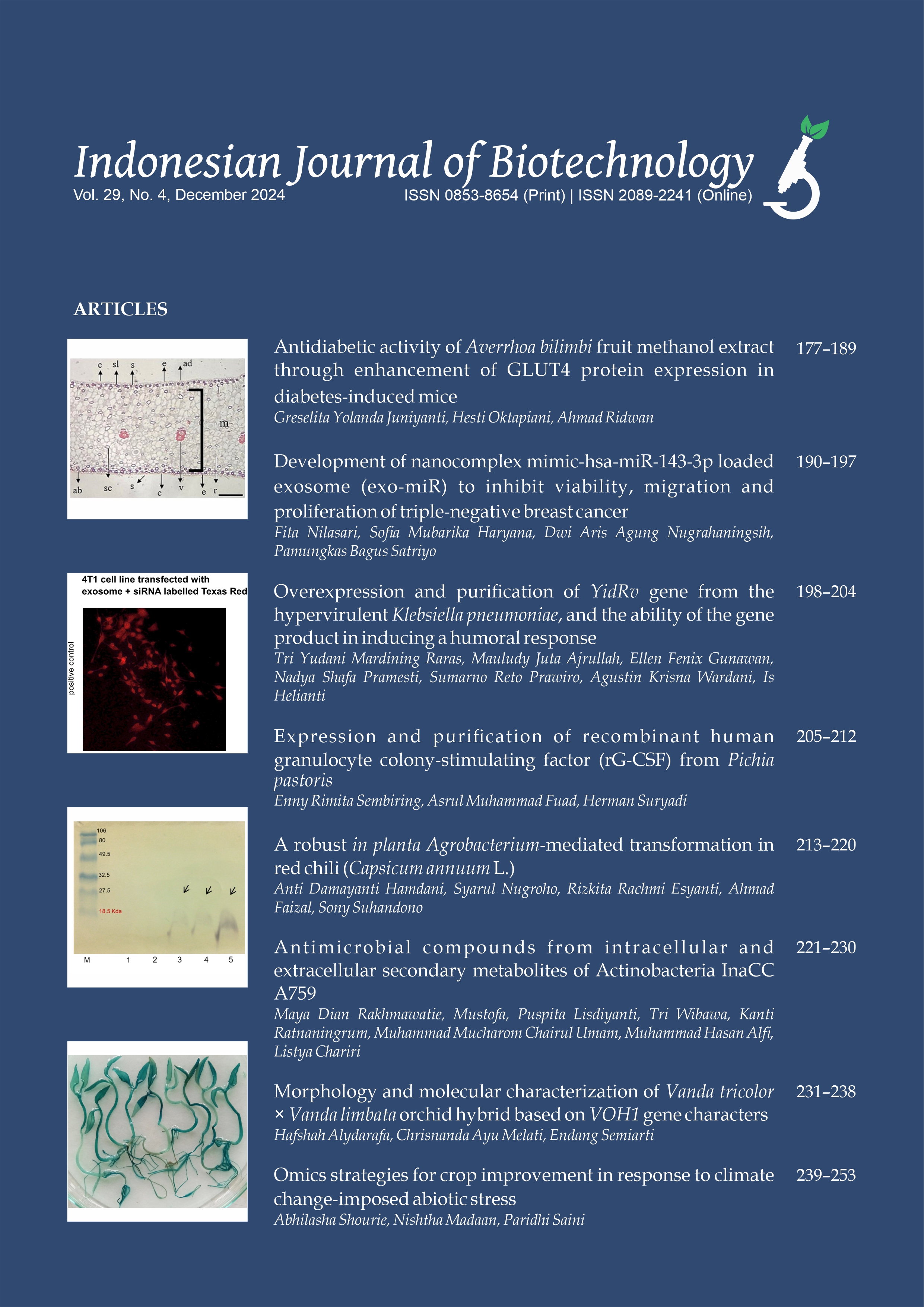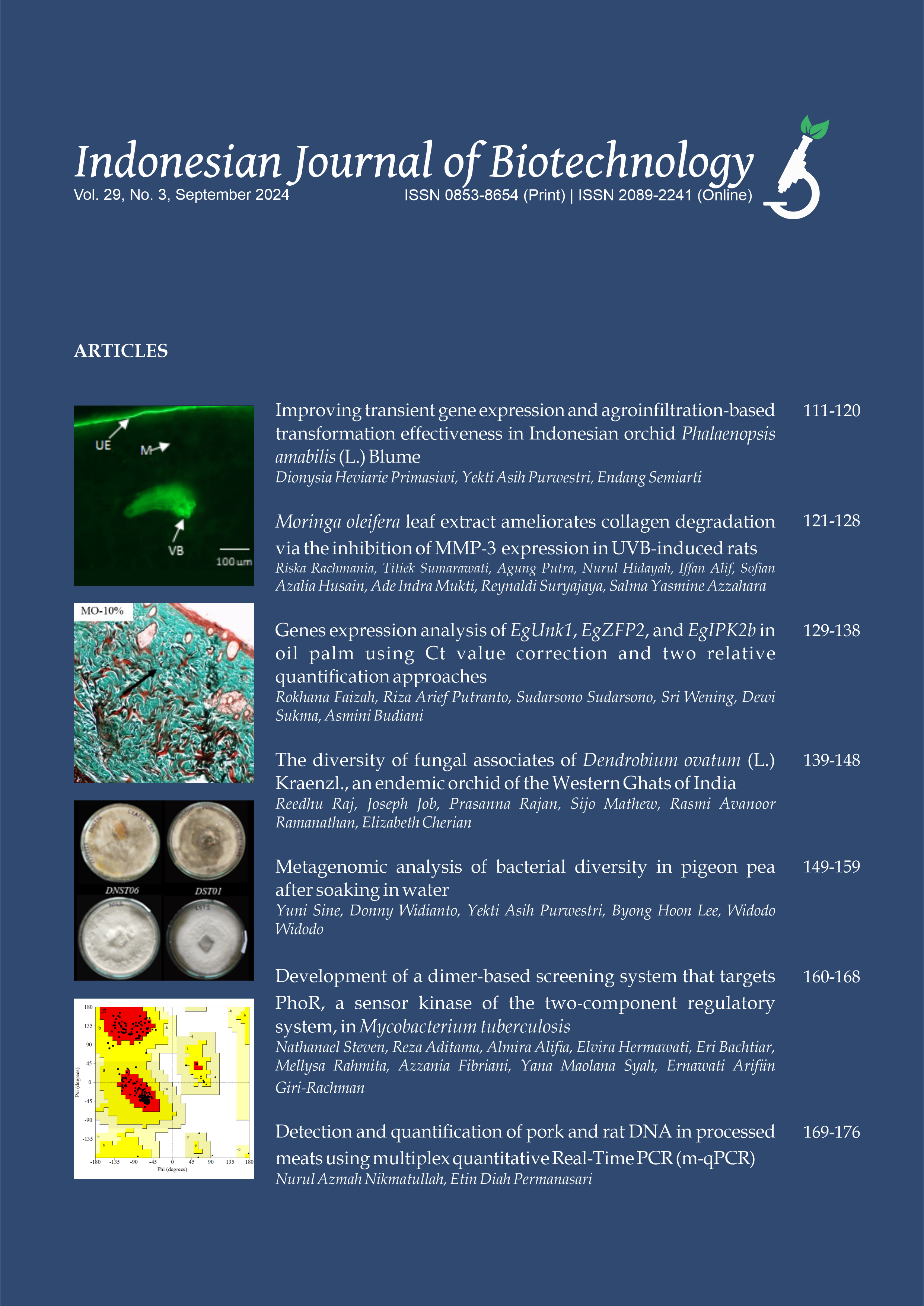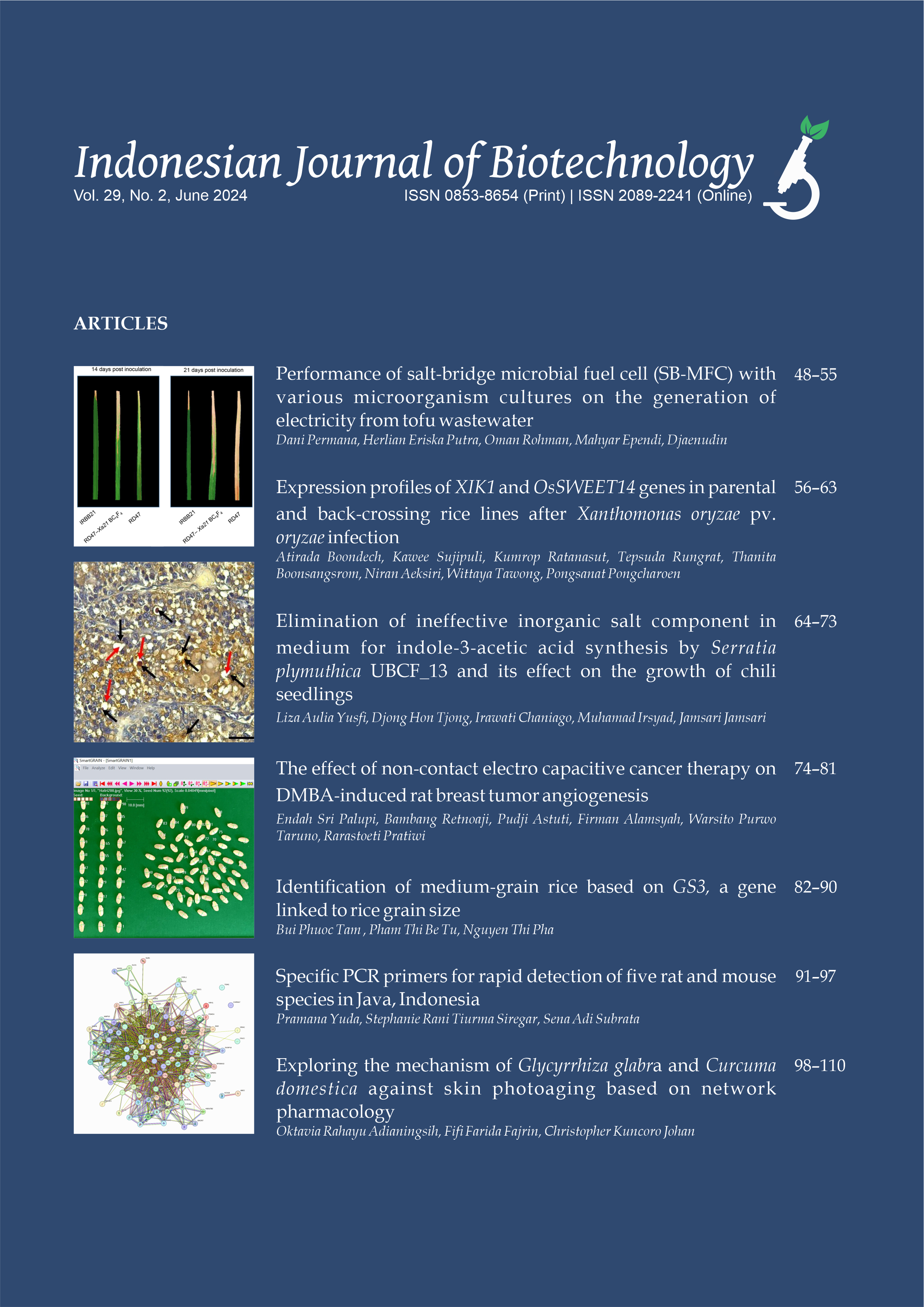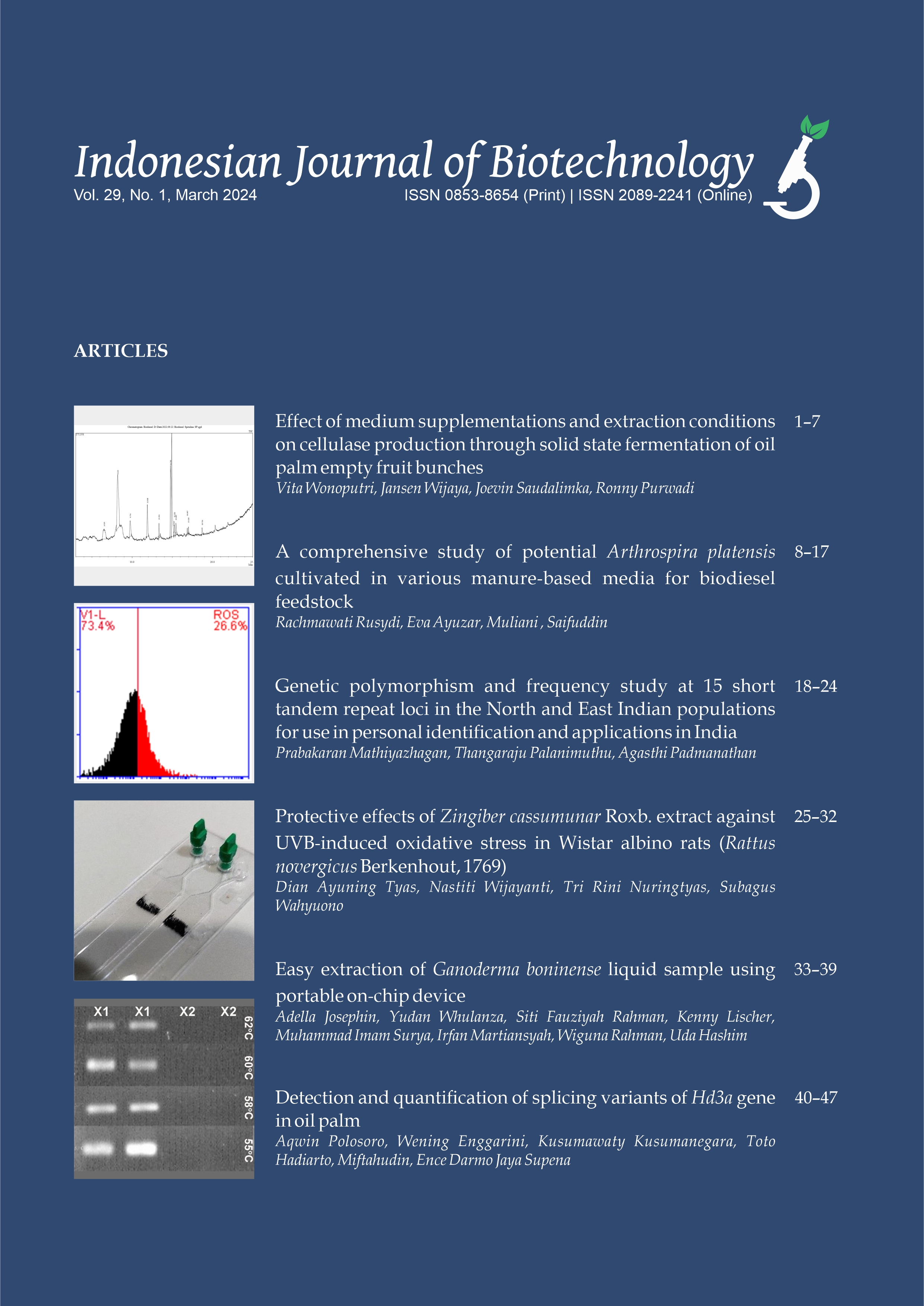Antimicrobial compounds from intracellular and extracellular secondary metabolites of Actinobacteria InaCC A759
Maya Dian Rakhmawatie(1*), Mustofa Mustofa(2), Puspita Lisdiyanti(3), Tri Wibawa(4), Kanti Ratnaningrum(5), Muhammad Mucharom Chairul Umam(6), Muhammad Hasan Alfi(7), Listya Chariri(8)
(1) Department of Biomedical Sciences, Faculty of Medicine, Universitas Muhammadiyah Semarang, Jl. Kedung Mundu Raya No.18, Semarang 50273, Indonesia
(2) Department of Pharmacology and Therapy, Faculty of Medicine, Public Health and Nursing, Universitas Gadjah Mada, Jl. Farmako Sekip Utara, Yogyakarta 55281, Indonesia
(3) Research Center for Biotechnology, the National Research and Innovation Agency, Jl. Raya Jakarta‐Bogor Km. 46, Bogor 16911, Indonesia
(4) Department of Microbiology, Faculty of Medicine, Public Health and Nursing, Universitas Gadjah Mada, Jl. Farmako Sekip Utara, Yogyakarta 55281, Indonesia
(5) Department of Biomedical Sciences, Faculty of Medicine, Universitas Muhammadiyah Semarang, Jl. Kedung Mundu Raya No.18, Semarang 50273, Indonesia
(6) Graduated Student, Faculty of Medicine, Universitas Muhammadiyah Semarang, Jl. Kedung Mundu Raya No. 18, Semarang 50273, Indonesia
(7) Graduated Student, Faculty of Medicine, Universitas Muhammadiyah Semarang, Jl. Kedung Mundu Raya No. 18, Semarang 50273, Indonesia
(8) Graduated Student, Faculty of Medicine, Universitas Muhammadiyah Semarang, Jl. Kedung Mundu Raya No. 18, Semarang 50273, Indonesia
(*) Corresponding Author
Abstract
Keywords
Full Text:
PDFReferences
ÁlvarezMartínez FJ, BarrajónCatalán E, HerranzLópez M, Micol V. 2021. Antibacterial plant compounds, extracts and essential oils: An updated review on their effects and putative mechanisms of action. Phytomedicine 90:153626. doi:10.1016/j.phymed.2021.153626.
Arthur PK, Amarh V, Cramer P, Arkaifie GB, Blessie EJ, Fuseini MS, Carilo I, Yeboah R, Asare L, Robertson BD. 2019. Characterization of two new multidrugresistant strains of Mycobacterium smegmatis: Tools for routine in vitro screening of novel antimycobacterial agents. Antibiotics 8(1):4. doi:10.3390/antibiotics8010004.
BrownElliott BA, Nash KA, Wallace RJ. 2012. Antimicrobial susceptibility testing, drug resistance mechanisms, and therapy of infections with nontuberculous Mycobacteria. Clin. Microbiol. Rev. 25(3):545–582. doi:10.1128/CMR.0503011.
CasillasVargas G, OcasioMalavé C, Medina S, MoralesGuzmán C, Del Valle RG, Carballeira NM, SanabriaRíos DJ. 2021. Antibacterial fatty acids: An update of possible mechanisms of action and implications in the development of the nextgeneration of antibacterial agents. Prog. Lipid Res. 82:101093. doi:10.1016/j.plipres.2021.101093.
Chassagne F, Samarakoon T, Porras G, Lyles JT, Dettweiler M, Marquez L, Salam AM, Shabih S, Farrokhi DR, Quave CL. 2021. A systematic review of plants with antibacterial activities: A taxonomic and phylogenetic perspective. Front. Pharmacol. 11:586548. doi:10.3389/fphar.2020.586548.
Chong ZY, Sandanamsamy S, Ismail NN, Mohamad S, Mohd Hanafiah K. 2021. Bioguided fractionation of oil palm (Elaeis guineensis) fruit and interactions of compounds with firstline antituberculosis drugs against Mycobacterium tuberculosis h37ra. Separations 8(2):19. doi:10.3390/SEPARATIONS8020019.
Clavo RF, Pereira AK, Quiñones NR, Costa JH. 2022. Metabolomic comparison using Streptomyces spp. as a factory of secondary metabolites. Preprints (April):1–14.
Clinical and Laboratory Standards Institute (CLSI). 2020. Performance standards for antimicrobial susceptibility testing 30th edition: CLSI supplement M100. Pensylvania: CLSI.
Dahham SS, Tabana YM, Iqbal MA, Ahamed MB, Ezzat MO, Majid AS, Majid AM. 2015. The anticancer, antioxidant and antimicrobial properties of the sesquiterpene βcaryophyllene from the essential oil of Aquilaria crassna. Molecules 20(7):11808–11829. doi:10.3390/molecules200711808.
Dahl JU, Gray MJ, Bazopoulou D, Beaufay F, Lempart J, Koenigsknecht MJ, Wang Y, Baker JR, Hasler WL, Young VB, Sun D, Jakob U. 2017. The antiinflammatory drug mesalamine targets bacterial polyphosphate accumulation. Nat. Microbiol. 2:16267. doi:10.1038/nmicrobiol.2016.267.
Damayanti E, Lisdiyanti P, Sundowo A, Ratnakomala S, Dinoto A, Widada J, Mustofa. 2021. Antiplasmodial activity, biosynthetic gene clusters diversity, and secondary metabolite constituent of selected Indonesian Streptomyces. Biodiversitas 22(6):3478– 3487. doi:10.13057/biodiv/d220657.
Dasyam N. 2014. Identification of antitubercular compounds in marine organisms from Aotearoa. Doctoral thesis, Victoria University of Wellington, Wellington. Desbois AP, Smith VJ. 2010. Antibacterial free fatty acids: Activities, mechanisms of action and biotechnological potential. Appl. Microbiol. Biotechnol. 85(6):1629–1642. doi:10.1007/s0025300923553.
Djinni I, Defant A, Kecha M, Mancini I. 2014. Metabolite profile of marinederived endophytic Streptomyces sundarbansensis WR1L1S8 by liquid chromatographymass spectrometry and evaluation of culture conditions on antibacterial activity and mycelial growth. J. Appl. Microbiol. 116(1):39–50. doi:10.1111/jam.12360.
dos Santos JDN, João SA, Martín J, Vicente F, Reyes F, Lage OM. 2022. iChipinspired isolation, bioactivities and dereplication of actinomycetota from Portuguese beach sediments. Microorganisms 10(7):1471. doi:10.3390/microorganisms10071471.
He Z, De Buck J. 2010. Cell wall proteome analysis of Mycobacterium smegmatis strain MC2 155. BMC Microbiol. 10:121. doi:10.1186/1471218010121.
Heidari B, Mohammadipanah F. 2018. Isolation and identification of two alkaloid structures with radical scavenging activity from Actinokineospora sp. UTMC 968, a new promising source of alkaloid compounds. Mol. Biol. Rep. 45(6):2325–2332. doi:10.1007/s1103301843951.
Hudson MA, Lockless SW. 2022. Elucidating the mechanisms of action of antimicrobial agents. MBio 13:e02240–21. doi:10.1128/mbio.0224021.
Husain DR, Wardhani R. 2021. Antibacterial activity of endosymbiotic bacterial compound from Pheretima sp. earthworms inhibit the growth of Salmonella typhi and Staphylococcus aureus: In vitro and in silico approach. Iran. J. Microbiol. 13(4):537–543. doi:10.18502/ijm.v13i4.6981.
IACG. 2019. No time to wait: Securing the future from drugresistant infections. Geneva: World Health Organization. Kibret M, GuerreroGarzón JF, Urban E, Zehl M, Wronski VK, Rückert C, Busche T, Kalinowski J, Rollinger JM, Abate D, Zotchev SB. 2018. Streptomyces spp. from Ethiopia producing antimicrobial compounds: Characterization via bioassays, genome analyses, and mass spectrometry. Front. Microbiol. 9:1270. doi:10.3389/fmicb.2018.01270.
Kim WJ, Kim YO, Kim JH, Nam BH, Kim DG, An CM, Lee JS, Kim PS, Lee HM, Oh JS, Lee JS. 2016. Liquid chromatographymass spectrometrybased rapid secondarymetabolite profiling of marine Pseudoalteromonas sp. M2. Mar. Drugs 14(1):24. doi:10.3390/md14010024.
Kumar S, Stecher G, Tamura K. 2016. MEGA7: Molecular evolutionary genetics analysis version 7.0 for bigger datasets. Mol Biol Evol. 33(7):1870–1874. doi:10.1093/molbev/msw054.
Liu Z, Yaoyao S, Lili H, Yongjun Z, Houwen L. 2020. Study on secondary metabolites from spongesymbiotic Streptomyces sp. LHW2432. J. Pharm. Pract. 38(5):418–422. doi:10.12206/j.issn.1006 0111.202001071.
MacKinnon MC, Sargeant JM, Pearl DL, ReidSmith RJ, Carson CA, Parmley EJ, McEwen SA. 2020. Evaluation of the health and healthcare system burden due to antimicrobialresistant Escherichia coli infections in humans: a systematic review and metaanalysis. Antimicrob. Resist. Infect. Control 9:200. doi:10.1186/s1375602000863x.
Mast Y, Stegmann E. 2019. Actinomycetes: The antibiotics producers. Antibiotics 8(3):105. doi:10.3390/antibiotics8030105.
Mushtaq MY, Choi YH, Verpoorte R, Wilson EG. 2014. Extraction for metabolomics: Access to the metabolome. Phytochem. Anal. 25(4):291–306. doi:10.1002/pca.2505.
Nirwati H, Damayanti E, Sholikhah EN, Mutofa M, Widada J. 2022. Soilderived Streptomyces sp. GMR22 producing antibiofilm activity against Candida albicans: bioassay, untargeted LCHRMS, and gene cluster analysis. Heliyon 8(4):e09333. doi:10.1016/j.heliyon.2022.e09333.
Pinu FR, VillasBoas SG. 2017. Extracellular microbial metabolomics: The state of the art. Metabolites 7(3):43. doi:10.3390/metabo7030043.
Pinu FR, VillasBoas SG, Aggio R. 2017. Analysis of intracellular metabolites from microorganisms: Quenching and extraction protocols. Metabolites 7(4):53. doi:10.3390/metabo7040053.
Quinn GA, Banat AM, Abdelhameed AM, Banat IM. 2020. Streptomyces from traditional medicine: sources of new innovations in antibiotic discovery. J. Med. Microbiol. 69(8):1040–1048. doi:10.1099/jmm.0.001232.
Rajaram SK, Ahmad P, Sujani Sathya Keerthana S, Jeya Cressida P, Ganesh Moorthy I, Suresh RS. 2020. Extraction and purification of an antimicrobial bioactive element from lichen associated Streptomyces olivaceus LEP7 against wound inhabiting microbial pathogens. J. King Saud Univ. Sci. 32(3):2009– 2015. doi:10.1016/j.jksus.2020.01.039.
Rakhmawatie MD, Wibawa T, Lisdiyanti P, Pratiwi WR, Damayanti E, Mustofa. 2021. Potential secondary metabolite from Indonesian Actinobacteria (InaCC A758) against Mycobacterium tuberculosis. Iran. J. Basic Med. Sci. 24(8):1058–1068. doi:10.22038/ijbms.2021.56468.12601.
Rakhmawatie MD, Wibawa T, Lisdiyanti P, Pratiwi WR, Mustofa. 2019. Evaluation of crystal violet decolorization assay and resazurin microplate assay for antimycobacterial screening. Heliyon 5(8):e02263. doi:10.1016/j.heliyon.2019.e02263.
Reina JC, PérezVictoria I, Martín J, Llamas I. 2019. A quorumsensing inhibitor strain of Vibrio alginolyticus blocks Qscontrolled phenotypes in Chromobacterium violaceum and Pseudomonas aeruginosa. Mar. Drugs 17(9):494. doi:10.3390/md17090494.
Retnowati Y, Moeljopawiro S, Djohan TS, Soetarto ES. 2018. Antimicrobial activities of actinomycete isolates from rhizospheric soils in different mangrove forests of Torosiaje, Gorontalo, Indonesia. Biodiversitas 19(6):2196–2203. doi:10.13057/biodiv/d190627.
Selim MSM, Abdelhamid SA, Mohamed SS. 2021. Secondary metabolites and biodiversity of actinomycetes. J. Genet. Eng. Biotechnol. 19(1):72. doi:10.1186/s43141021001569.
Serwecińska L. 2020. Antimicrobials and antibioticresistant bacteria: A risk to the environment and to public health. Water (Switzerland) 12(12):3313. doi:10.3390/w12123313.
Seyedsayamdost MR. 2019. Toward a global picture of bacterial secondary metabolism. J. Ind. Microbiol. Biotechnol. 46(3):301–311. doi:10.1007/s1029501902136y.
Silva ACO, Santana EF, Saraiva AM, Coutinho FN, Castro RHA, Pisciottano MNC, Amorim ELC, Albuquerque UP. 2013. Which approach is more effective in the selection of plants with antimicrobial activity? Evidencebased Complement. Altern. Med. 2013:308980. doi:10.1155/2013/308980.
Song HS, Choi TR, Bhatia SK, Lee SM, Park SL, Lee HS, Kim YG, Kim JS, Kim W, Yang YH. 2020. Combination therapy using lowconcentration oxacillin with palmitic acid and span85 to control clinical methicillinresistant Staphylococcus aureus. Antibiotics 9(10):682. doi:10.3390/antibiotics9100682.
Sun C, Zhang C, Qin X, Wei X, Liu Q, Li Q, Ju J. 2018. Genome mining of Streptomyces olivaceus SCSIO T05: Discovery of olimycins A and B and assignment of absolute configurations. Tetrahedron 74(1):199– 203. doi:10.1016/j.tet.2017.11.069.
Sung JS, Collins MT. 2008. Thiopurine drugs azathioprine and 6mercaptopurine inhibit Mycobacterium paratuberculosis growth in vitro. Antimicrob. Agents Chemother. 52(2):418–426. doi:10.1128/AAC.0067807.
T JAS, J R, Rajan A, Shankar V. 2020. Features of the biochemistry of Mycobacterium smegmatis, as a possible model for Mycobacterium tuberculosis. J. Infect. Public Health 13(9):1255–1264. doi:10.1016/j.jiph.2020.06.023.
Tian Y, Li YL, Zhao FC. 2017. Secondary metabolites from polar organisms. Mar. Drugs 15(3):1–30. doi:10.3390/md15030028.
Um S, Lee J, Kim SH. 2022. Lobophorin producing endophytic Streptomyces olivaceus JB1 associated with Maesa japonica (Thunb.) Moritzi & Zoll. Front. Microbiol. 13:881253. doi:10.3389/fmicb.2022.881253.
Van Ingen J, Boeree MJ, Van Soolingen D, Mouton JW. 2012. Resistance mechanisms and drug susceptibility testing of nontuberculous Mycobacteria. Drug Resist. Updat. 15(3):149–161. doi:10.1016/j.drup.2012.04.001.
van Rensburg W, Laubscher WE, Rautenbach M. 2021. High throughput method to determine the surface activity of antimicrobial polymeric materials. MethodsX 8:101593. doi:10.1016/j.mex.2021.101593.
Voytsekhovskaya IV, AxenovGribanov DV, Murzina SA, Pekkoeva SN, Protasov ES, Gamaiunov SV, Timofeyev MA. 2018. Estimation of antimicrobial activities and fatty acid composition of actinobacteria isolated from water surface of underground lakes from Badzheyskaya and Okhotnichya caves in Siberia. PeerJ 6:e5832. doi:10.7717/peerj.5832.
Watson DG. 2013. A rough guide to metabolite identification using high resolution liquid chromatography mass spectrometry in metabolomic profiling in metazoans. Comput. Struct. Biotechnol. J. 4:e201301005. doi:10.5936/csbj.201301005.
Wei Y, Zhang L, Zhou Z, Yan X. 2018. Diversity of gene clusters for polyketide and nonribosomal peptide biosynthesis revealed by metagenomic analysis of the yellow sea sediment. Front. Microbiol. 9:295. doi:10.3389/fmicb.2018.00295.
World Health Organization. 2017. Prioritization of pathogens to guide discovery, research, and development of new antibiotics for drugresistant bacterial infections, including tuberculosis. Geneva: World Health Organization.
World Health Organization. 2019a. Antibacterial agents in clinical development: an analysis of the antibacterial clinical development pipeline. Geneva: World Health Organization.
World Health Organization. 2019b. Antibacterial agents in preclinical development: an open access database. Geneva: World Health Organization.
Zhang C, Ding W, Qin X, Ju J. 2019. Genome sequencing of Streptomyces olivaceus SCSIO T05 and activated production of lobophorin CR4 via metabolic engineering and genome mining. Mar. Drugs 17(10):593. doi:10.3390/md17100593.
Article Metrics
Refbacks
- There are currently no refbacks.
Copyright (c) 2024 The Author(s)

This work is licensed under a Creative Commons Attribution-ShareAlike 4.0 International License.









